The Cambridge History of China. Vol. 06. Alien Regimes and Border States, 907-1368
Подождите немного. Документ загружается.

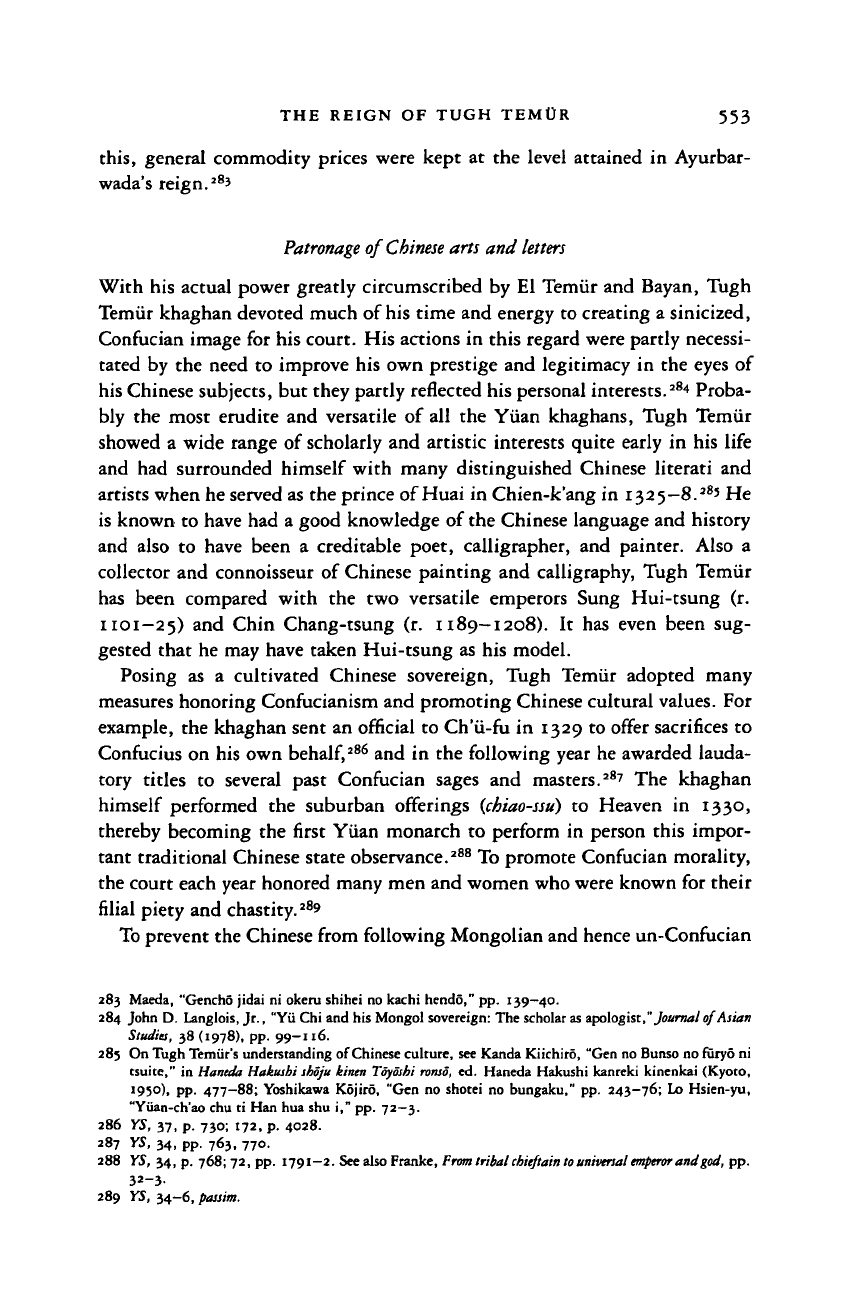
THE REIGN OF TUGH TEMOR 553
this,
general commodity prices were kept at the level attained in Ayurbar-
wada's reign.
28
'
Patronage of Chinese arts and letters
With his actual power greatly circumscribed by El Temiir and Bayan, Tugh
Temiir khaghan devoted much of his time and energy to creating a sinicized,
Confucian image for his court. His actions in this regard were partly necessi-
tated by the need to improve his own prestige and legitimacy in the eyes of
his Chinese subjects, but they partly reflected his personal interests.
284
Proba-
bly the most erudite and versatile of all the Yuan khaghans, Tugh Temiir
showed a wide range of scholarly and artistic interests quite early in his life
and had surrounded himself with many distinguished Chinese literati and
artists when he served as the prince of Huai in Chien-k'ang in 1325-8.
j8
' He
is known to have had a good knowledge of the Chinese language and history
and also to have been a creditable poet, calligrapher, and painter. Also a
collector and connoisseur of Chinese painting and calligraphy, Tugh Temiir
has been compared with the two versatile emperors Sung Hui-tsung (r.
1101-25) and Chin Chang-tsung (r. 1189-1208). It has even been sug-
gested that he may have taken Hui-tsung as his model.
Posing as a cultivated Chinese sovereign, Tugh Temiir adopted many
measures honoring Confucianism and promoting Chinese cultural values. For
example, the khaghan sent an official to Ch'ii-fu in 1329 to offer sacrifices to
Confucius on his own
behalf,
286
and in the following year he awarded lauda-
tory titles to several past Confucian sages and masters.
287
The khaghan
himself performed the suburban offerings
(cbiao-ssu)
to Heaven in 1330,
thereby becoming the first Yuan monarch to perform in person this impor-
tant traditional Chinese state observance.
288
To promote Confucian morality,
the court each year honored many men and women who were known for their
filial piety and chastity.
28
*
To prevent the Chinese from following Mongolian and hence un-Confucian
283 Maeda, "Gencho jidai ni okeru shihei no kachi hendo," pp. 139—40.
284 John D. Langlois, Jr., "Yu Chi and his Mongol sovereign: The scholar as apologise, "Journal of Asian
Studio, 38(1978), pp. 99—116.
285 On Tugh Temiir's understanding of Chinese culture, see Kanda Kiichiro, "Gen no Bunso no furyo ni
rsuite," in Haneda Hakushi shoju kinen Tdyoshi
ronso,
ed. Haneda Hakushi kanrcki kinenkai (Kyoto,
'95°).
PP- 477-88; Yoshikawa Kojiro, "Gen no shotei no bungaku," pp. 243-76; Lo Hsien-yu,
"Yuan-ch'ao chu ti Han hua shu i," pp.
72—3.
286 YS, 37, p. 730; 172, p. 4028.
287 YS, 34, pp. 763, 770.
288 YS, 34, p. 768; 72, pp. 1791-2. See also Franke,
From
tribal
chieftain to universal emperor
and god, pp.
32-3-
289 YS, 34-6, passim.
Cambridge Histories Online © Cambridge University Press, 2008
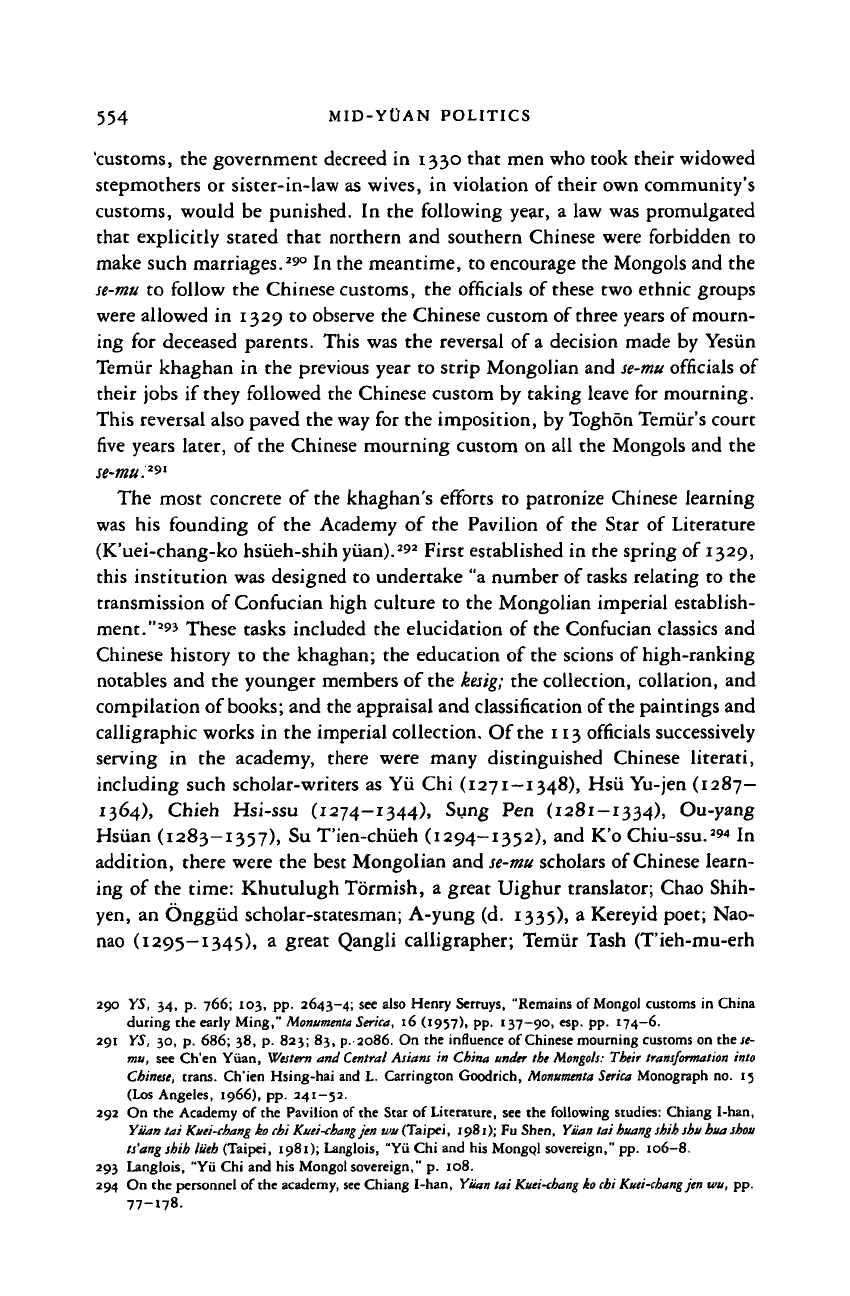
554 MID-YOAN POLITICS
'customs, the government decreed in 1330 that men who took their widowed
stepmothers or sister-in-law as wives, in violation of their own community's
customs, would be punished. In the following year, a law was promulgated
that explicitly stated that northern and southern Chinese were forbidden to
make such marriages.
290
In the meantime, to encourage the Mongols and the
se-mu
to follow the Chinese customs, the officials of these two ethnic groups
were allowed in 1329 to observe the Chinese custom of
three
years of mourn-
ing for deceased parents. This was the reversal of a decision made by Yesiin
Temiir khaghan in the previous year to strip Mongolian and
se-mu
officials of
their jobs if they followed the Chinese custom by taking leave for mourning.
This reversal also paved the way for the imposition, by Toghon Temiir's court
five years later, of the Chinese mourning custom on all the Mongols and the
se-mu.
2S>I
The most concrete of the khaghan's efforts to patronize Chinese learning
was his founding of the Academy of the Pavilion of the Star of Literature
(K'uei-chang-ko hsiieh-shih yiian).
292
First established in the spring of 1329,
this institution was designed to undertake "a number of
tasks
relating to the
transmission of Confucian high culture to the Mongolian imperial establish-
ment.
"
3
93
These tasks included the elucidation of the Confucian classics and
Chinese history to the khaghan; the education of the scions of high-ranking
notables and the younger members of the
kesig;
the collection, collation, and
compilation of
books;
and the appraisal and classification of the paintings and
calligraphic works in the imperial collection. Of
the
113 officials successively
serving in the academy, there were many distinguished Chinese literati,
including such scholar-writers as Yii Chi (1271
—1348),
Hsu Yu-jen (1287—
1364),
Chieh Hsi-ssu (1274-1344), Sung Pen (1281-1334), Ou-yang
Hsiian (1283-1357), Su T'ien-chiieh (1294-1352), and K'o Chiu-ssu.
294
In
addition, there were the best Mongolian and
se-mu
scholars of Chinese learn-
ing of the time: Khutulugh Tormish, a great Uighur translator; Chao Shih-
yen, an Onggiid scholar-statesman; A-yung (d. 1335), a Kereyid poet; Nao-
nao (1295-1345), a great Qangli calligrapher; Temiir Tash (T'ieh-mu-erh
290 YS, 34, p. 766; 103, pp. 2643-4; see
also Henry
Sertuys,
"Remains
of
Mongol customs
in
China
during
the
early
Ming,"
Monumenta
Serica,
16 (1957), pp. 137—90, esp. pp. 174-6.
291 YS, 30, p. 686; 38, p. 823; 83, p. 2086. On the
influence
of
Chinese mourning customs
on the
se-
mu, see
Ch'en
Yiian,
Western
and
Central Asians
in
China under
the
Mongols:
Their transformation into
Chinese,
trans.
Ch'ien Hsing-hai
and L.
Carrington
Goodrich,
Monumenta Serica Monograph
no. 15
(Los Angeles, 1966), pp. 241-52.
292 On the
Academy
of the
Pavilion
of the
Star
of
Literature,
see the
following
studies:
Chiang
1-han,
Yuan
tai
Kuei-chang
ko chi
Kuei-cbang
jen
urn
(Taipei,
1981); Fu Shen,
Yuan
tai
buang sbib
sbu bua
shou
ts'angshih liieh
(Taipei,
1981); Langlois, "Yii Chi and his
Mongo.1
sovereign," pp. 106-8.
293 Langlois, "Yu Chi and his
Mongol
sovereign," p. 108.
294 On the
personnel
of the
academy,
see
Chiang
I-han,
Yiian
tai
Kuei-cbang
ko chi
Kuei-chang
jen
urn,
pp.
77-178.
Cambridge Histories Online © Cambridge University Press, 2008
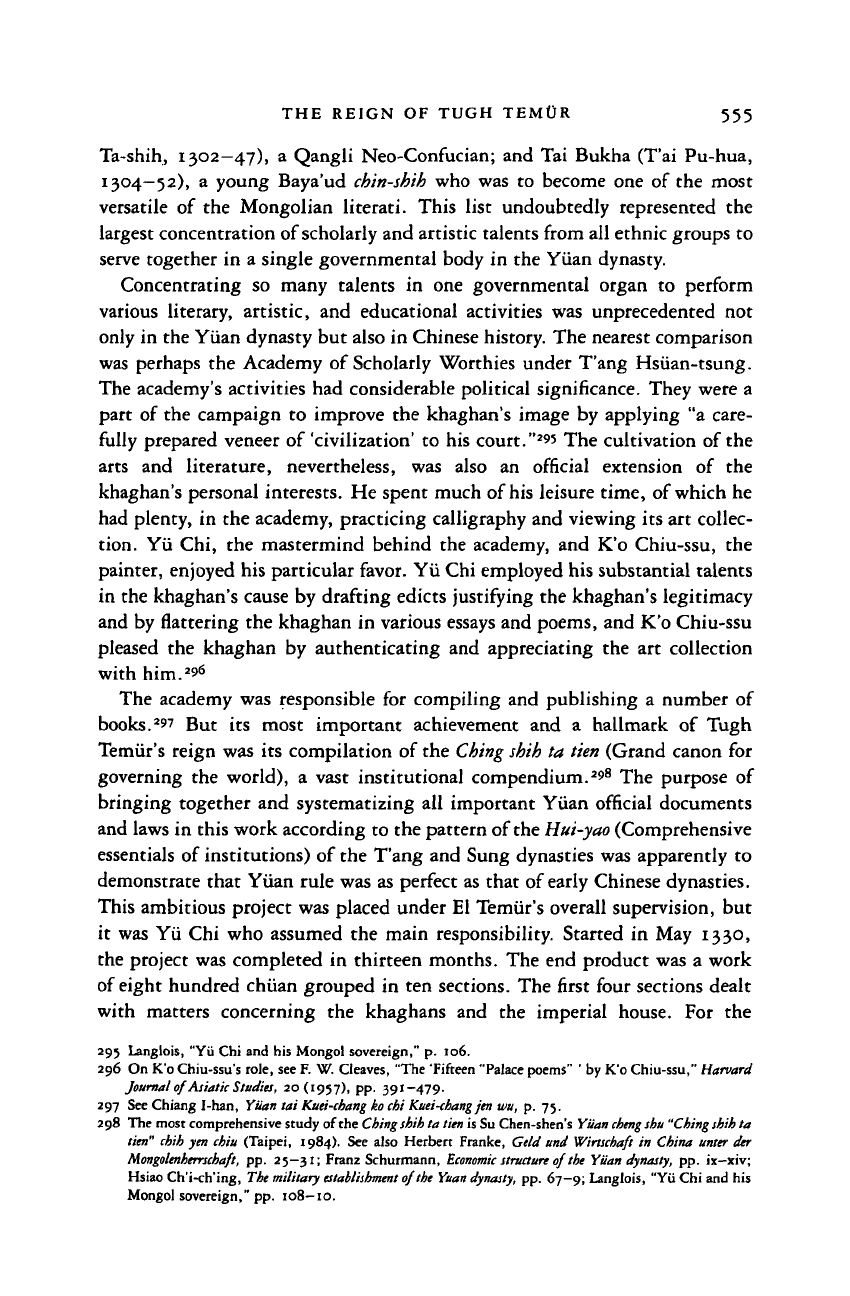
THE REIGN OF TUGH TEMOR 555
Ta-shih, 1302—47), a Qangli Neo-Confucian; and Tai Bukha (T'ai Pu-hua,
1304-52), a young Baya'ud chin-shih who was to become one of the most
versatile of the Mongolian literati. This list undoubtedly represented the
largest concentration of scholarly and artistic talents from all ethnic groups to
serve together in a single governmental body in the Yuan dynasty.
Concentrating so many talents in one governmental organ to perform
various literary, artistic, and educational activities was unprecedented not
only in the Yuan dynasty but also in Chinese history. The nearest comparison
was perhaps the Academy of Scholarly Worthies under T'ang Hsiian-tsung.
The academy's activities had considerable political significance. They were a
part of the campaign to improve the khaghan's image by applying "a care-
fully prepared veneer of'civilization' to his court."
295
The cultivation of the
arts and literature, nevertheless, was also an official extension of the
khaghan's personal interests. He spent much of his leisure time, of which he
had plenty, in the academy, practicing calligraphy and viewing its art collec-
tion. Yii Chi, the mastermind behind the academy, and K'o Chiu-ssu, the
painter, enjoyed his particular favor. Yii Chi employed his substantial talents
in the khaghan's cause by drafting edicts justifying the khaghan's legitimacy
and by flattering the khaghan in various essays and poems, and K'o Chiu-ssu
pleased the khaghan by authenticating and appreciating the art collection
with him.
2
'
6
The academy was responsible for compiling and publishing a number of
books.
297
But its most important achievement and a hallmark of Tugh
Temiir's reign was its compilation of the Ching shih ta tien (Grand canon for
governing the world), a vast institutional compendium.
298
The purpose of
bringing together and systematizing all important Yuan official documents
and laws in this work according to the pattern of the Hui-yao (Comprehensive
essentials of institutions) of the T'ang and Sung dynasties was apparently to
demonstrate that Yuan rule was as perfect as that of early Chinese dynasties.
This ambitious project was placed under El Temiir's overall supervision, but
it was Yii Chi who assumed the main responsibility. Started in May 1330,
the project was completed in thirteen months. The end product was a work
of eight hundred chiian grouped in ten sections. The first four sections dealt
with matters concerning the khaghans and the imperial house. For the
295
Langlois,
"Yii Chi and his
Mongol
sovereign,"
p. 106.
296 On K'o
Chiu-ssu's
role,
see F. W.
Cleaves,
"The
'Fifteen "Palace
poems"
' by K'o
Chiu-ssu,"
Harvard
Journal
of
Asiatic
Studies,
20(1957),
pp.
391-479.
297 See Chiang I-han, Yuan tai Kuei-chang ko chi
Kuei-chang
jen wu, p. 75.
298 The most comprehensive study of the Ching
shih
ta
tien
is Su Chen-shen's Yuan
chtng shu "Ching shih
ta
tien"
chih yen chiu (Taipei, 1984). See also Herbert Franke, Geld und Wirtschaft in China unter der
Mongolenherrschaft,
pp.
25—31;
Franz Schurmann,
Economic structure
of
the
Yiian dynasty, pp. ix—xiv;
Hsiao Ch'i-ch'ing, The military
establishment
of the
Yuan
dynasty, pp. 67-9; Langlois, "Yii Chi and his
Mongol sovereign," pp. 108—10.
Cambridge Histories Online © Cambridge University Press, 2008
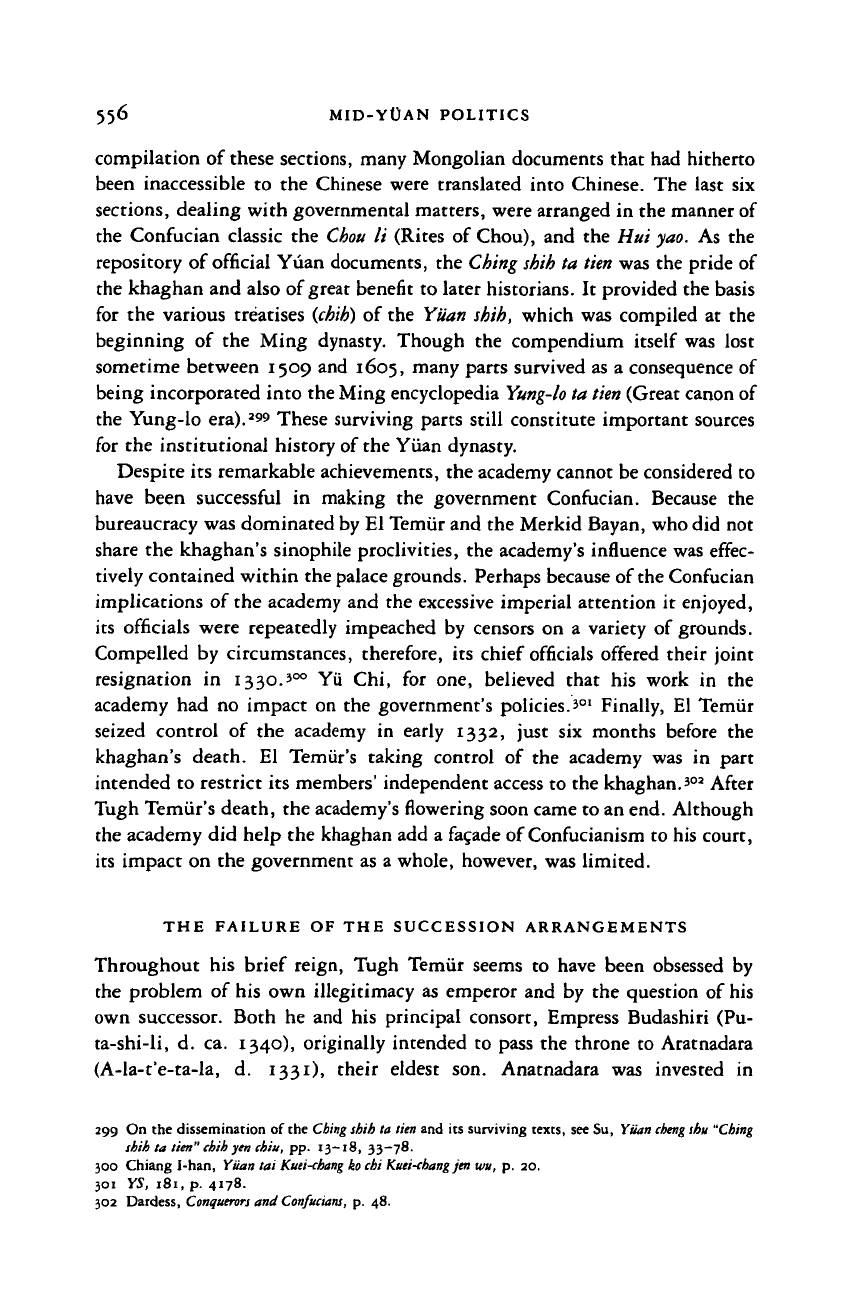
556
MID-YOAN POLITICS
compilation
of
these sections, many Mongolian documents that
had
hitherto
been inaccessible
to the
Chinese were translated into Chinese.
The
last
six
sections, dealing with governmental matters, were arranged
in the
manner of
the Confucian classic
the
Cbou
li
(Rites
of
Chou),
and the Hut
yao.
As the
repository
of
official Yuan documents,
the
Ching shih
ta
tien
was the
pride
of
the khaghan
and
also
of
great benefit
to
later historians.
It
provided
the
basis
for
the
various treatises
(cbib)
of the
Yuan
shih,
which
was
compiled
at the
beginning
of the
Ming dynasty. Though
the
compendium itself
was
lost
sometime between
1509 and 1605,
many parts survived
as a
consequence
of
being incorporated into the Ming encyclopedia
Yung-lo
ta
tien
(Great canon of
the Yung-lo era).
2
^9 These surviving parts still constitute important sources
for
the
institutional history
of
the Yiian dynasty.
Despite
its
remarkable achievements,
the
academy cannot
be
considered
to
have been successful
in
making
the
government Confucian. Because
the
bureaucracy was dominated by
El
Temiir
and the
Merkid Bayan, who
did not
share
the
khaghan's sinophile proclivities,
the
academy's influence was effec-
tively contained within the palace grounds. Perhaps because
of
the
Confucian
implications
of
the academy
and the
excessive imperial attention
it
enjoyed,
its officials were repeatedly impeached
by
censors
on a
variety
of
grounds.
Compelled
by
circumstances, therefore,
its
chief officials offered their joint
resignation
in
1330.3°°
Yii Chi, for one,
believed that
his
work
in the
academy
had no
impact
on the
government's policies.'
01
Finally,
El
Temiir
seized control
of the
academy
in
early
1332,
just
six
months before
the
khaghan's death.
El
Temiir's taking control
of the
academy
was in
part
intended
to
restrict
its
members' independent access
to the
khaghan.
*
03
After
Tugh Temiir's death,
the
academy's
flowering
soon came
to an
end. Although
the academy
did
help
the
khaghan
add a
facade
of
Confucianism
to
his court,
its impact
on the
government
as a
whole, however,
was
limited.
THE FAILURE
OF THE
SUCCESSION ARRANGEMENTS
Throughout
his
brief reign, Tugh Temiir seems
to
have been obsessed
by
the problem
of
his
own
illegitimacy
as
emperor
and by the
question
of his
own successor. Both
he and his
principal consort, Empress Budashiri
(Pu-
ta-shi-li,
d. ca.
1340), originally intended
to
pass
the
throne
to
Aratnadara
(A-la-t'e-ta-la,
d.
1331), their eldest
son.
Anatnadara
was
invested
in
299
On the
dissemination
of the
Ching
shih
ta
tien
and its
surviving texts,
see Su,
Yuan
chetig
shu
"Ching
shih ta
lien"
chih
yen
chiu,
pp. 13-18, 33-78.
300
Chiang I-han, Yiian
tai
Kuei-cbang
ko
chi
Kuei-chang Jen
wu, p. 20.
301
YS, 181, p. 4178.
302 Dardess,
Conquerors
and
Confucians,
p. 48.
Cambridge Histories Online © Cambridge University Press, 2008
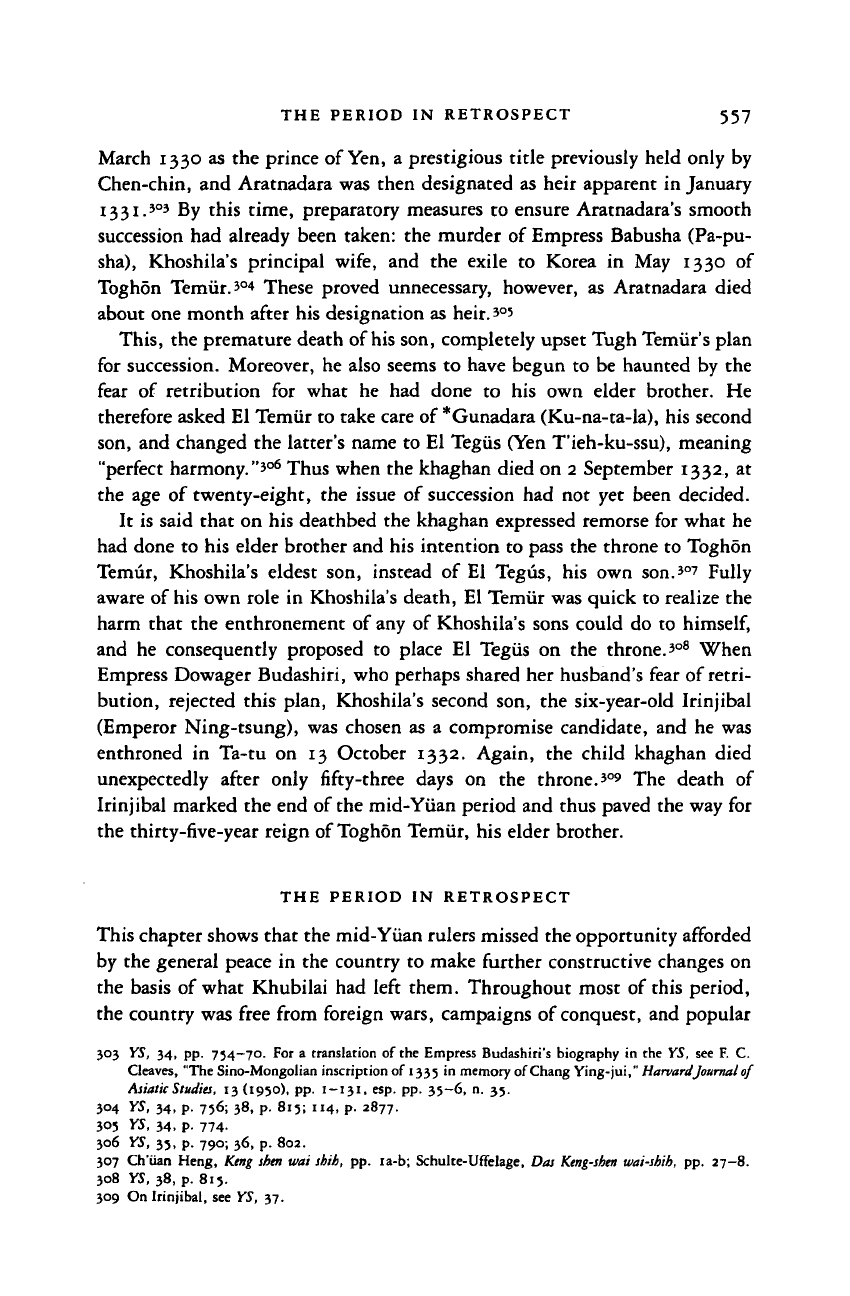
THE PERIOD IN RETROSPECT 557
March 1330 as the prince of Yen, a prestigious title previously held only by
Chen-chin, and Aratnadara was then designated as heir apparent in January
I
33
I
-
3
°
3
By this time, preparatory measures to ensure Aratnadara's smooth
succession had already been taken: the murder of Empress Babusha (Pa-pu-
sha),
Khoshila's principal wife, and the exile to Korea in May 1330 of
Toghon Temiir.5°
4
These proved unnecessary, however, as Aratnadara died
about one month after his designation as heir.*°'
This,
the premature death of his son, completely upset Tugh Temiir's plan
for succession. Moreover, he also seems to have begun to be haunted by the
fear of retribution for what he had done to his own elder brother. He
therefore asked El Temiir to take care of *Gunadara (Ku-na-ta-la), his second
son, and changed the latter's name to El Tegus (Yen T'ieh-ku-ssu), meaning
"perfect harmony."'
06
Thus when the khaghan died on 2 September 1332, at
the age of twenty-eight, the issue of succession had not yet been decided.
It is said that on his deathbed the khaghan expressed remorse for what he
had done to his elder brother and his intention to pass the throne to Toghon
Temur, Khoshila's eldest son, instead of El Tegus, his own son.*
0
? Fully
aware of his own role in Khoshila's death, El Temiir was quick to realize the
harm that the enthronement of any of Khoshila's sons could do to
himself,
and he consequently proposed to place El Tegus on the throne.3°
8
When
Empress Dowager Budashiri, who perhaps shared her husband's fear of retri-
bution, rejected this plan, Khoshila's second son, the six-year-old Irinjibal
(Emperor Ning-tsung), was chosen as a compromise candidate, and he was
enthroned in Ta-tu on 13 October 1332. Again, the child khaghan died
unexpectedly after only fifty-three days on the throne.
309
The death of
Irinjibal marked the end of the mid-Yiian period and thus paved the way for
the thirty-five-year reign of Toghon Temiir, his elder brother.
THE PERIOD IN RETROSPECT
This chapter shows that the mid-Yiian rulers missed the opportunity afforded
by the general peace in the country to make further constructive changes on
the basis of what Khubilai had left them. Throughout most of this period,
the country was free from foreign wars, campaigns of conquest, and popular
303 YS, 34, pp. 754—70. For a translation of the Empress Budashiri's biography in the YS, see F. C.
Cleaves, "The Sino-Mongolian inscription of 1335 in memory of Chang Ying-jui," Harvard
Journal of
Asiatic
Studies,
13 (1950), pp. 1—131, esp. pp. 35—6, n. 35.
304 YS, 34, p. 756; 38, p. 815; 114, p. 2877.
305 YS, 34, p. 774.
306 YS, 35, p. 790; 36, p. 802.
307 Ch'iian Heng,
Keng shen
wai
shih,
pp. la-b; Schulte-Uffelage, Das
Kmg-shen
wai-shih,
pp. 27-8.
308 YS, 38, p. 815.
309 On Irinjibal, see YS, 37.
Cambridge Histories Online © Cambridge University Press, 2008
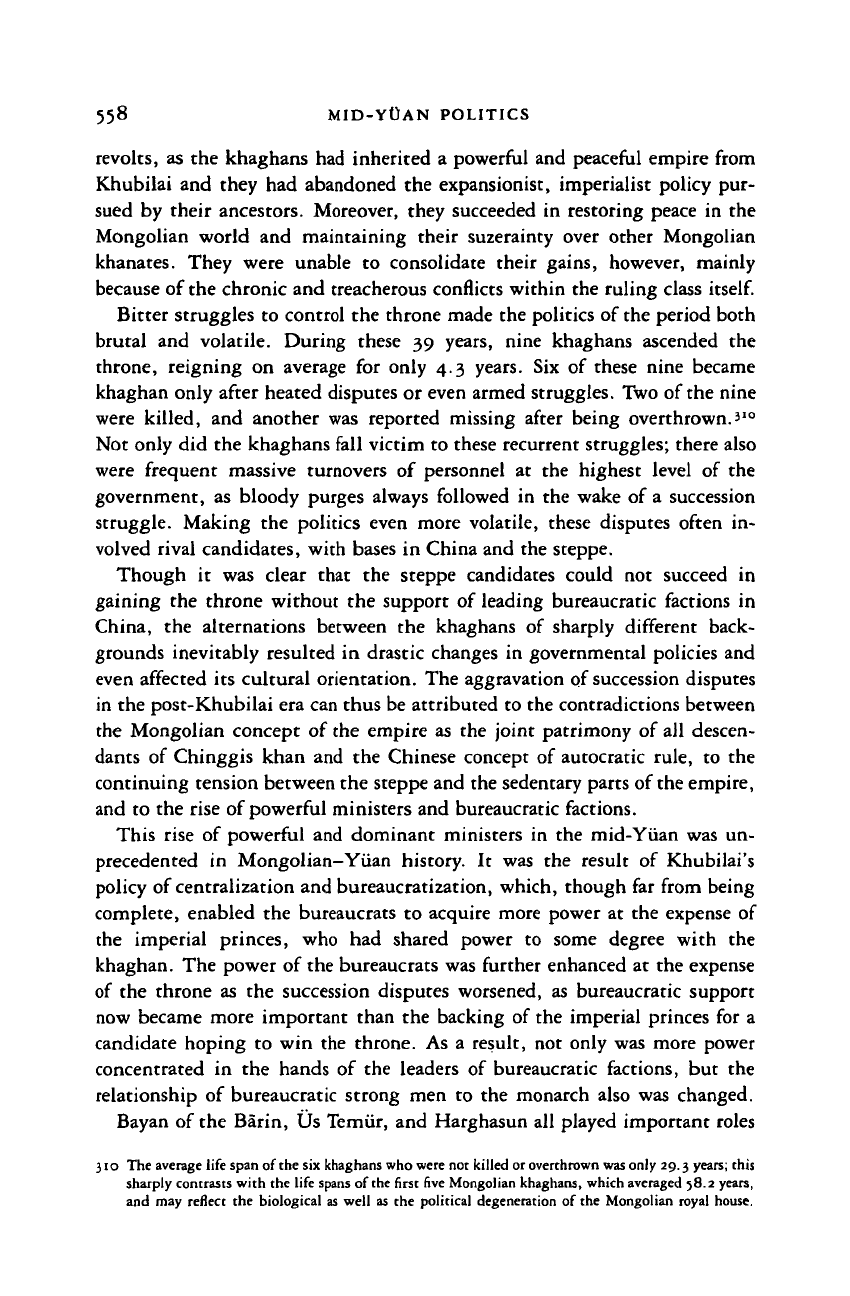
558 MID-YOAN POLITICS
revolts, as the khaghans had inherited a powerful and peaceful empire from
Khubilai and they had abandoned the expansionist, imperialist policy pur-
sued by their ancestors. Moreover, they succeeded in restoring peace in the
Mongolian world and maintaining their suzerainty over other Mongolian
khanates. They were unable to consolidate their gains, however, mainly
because of the chronic and treacherous conflicts within the ruling class
itself.
Bitter struggles to control the throne made the politics of the period both
brutal and volatile. During these 39 years, nine khaghans ascended the
throne, reigning on average for only 4.3 years. Six of these nine became
khaghan only after heated disputes or even armed struggles. Two of the nine
were killed, and another was reported missing after being overthrown.'
10
Not only did the khaghans fall victim to these recurrent struggles; there also
were frequent massive turnovers of personnel at the highest level of the
government, as bloody purges always followed in the wake of a succession
struggle. Making the politics even more volatile, these disputes often in-
volved rival candidates, with bases in China and the steppe.
Though it was clear that the steppe candidates could not succeed in
gaining the throne without the support of leading bureaucratic factions in
China, the alternations between the khaghans of sharply different back-
grounds inevitably resulted in drastic changes in governmental policies and
even affected its cultural orientation. The aggravation of succession disputes
in the post-Khubilai era can thus be attributed to the contradictions between
the Mongolian concept of the empire as the joint patrimony of all descen-
dants of Chinggis khan and the Chinese concept of autocratic rule, to the
continuing tension between the steppe and the sedentary parts of the empire,
and to the rise of powerful ministers and bureaucratic factions.
This rise of powerful and dominant ministers in the mid-Yuan was un-
precedented in Mongolian-Yuan history. It was the result of Khubilai's
policy of centralization and bureaucratization, which, though far from being
complete, enabled the bureaucrats to acquire more power at the expense of
the imperial princes, who had shared power to some degree with the
khaghan. The power of the bureaucrats was further enhanced at the expense
of the throne as the succession disputes worsened, as bureaucratic support
now became more important than the backing of the imperial princes for a
candidate hoping to win the throne. As a result, not only was more power
concentrated in the hands of the leaders of bureaucratic factions, but the
relationship of bureaucratic strong men to the monarch also was changed.
Bayan of the Barin, Us Temiir, and Harghasun all played important roles
310 The average life span of the six khaghans who were not killed or overthrown was only 29.3 years; this
sharply contrasts with the life spans of the first five Mongolian khaghans, which averaged 58.2 years,
and may reflect the biological as well as the political degeneration of the Mongolian royal house.
Cambridge Histories Online © Cambridge University Press, 2008
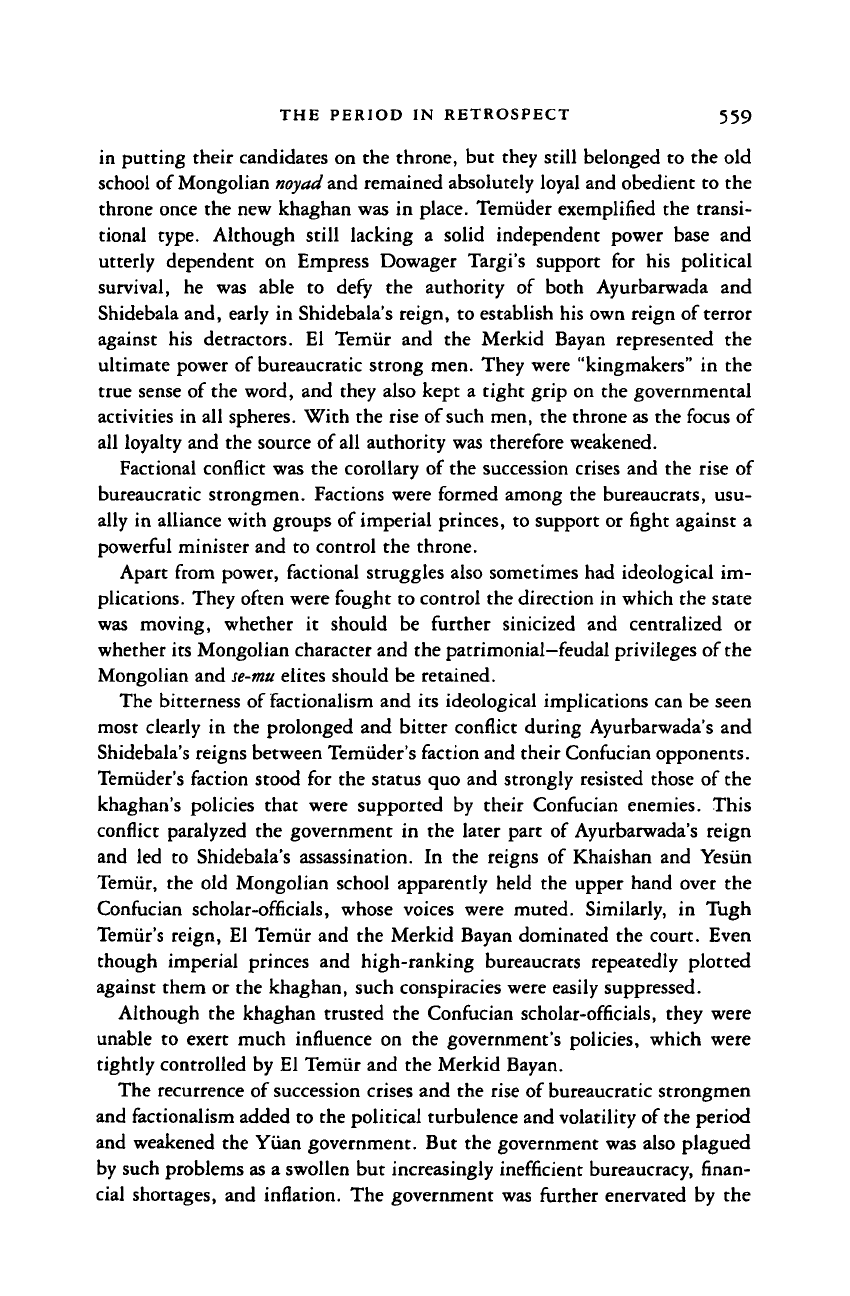
THE PERIOD IN RETROSPECT 559
in putting their candidates on the throne, but they still belonged to the old
school of Mongolian noyad and remained absolutely loyal and obedient to the
throne once the new khaghan was in place. Temiider exemplified the transi-
tional type. Although still lacking a solid independent power base and
utterly dependent on Empress Dowager Targi's support for his political
survival, he was able to defy the authority of both Ayurbarwada and
Shidebala and, early in Shidebala's reign, to establish his own reign of terror
against his detractors. El Temiir and the Merkid Bayan represented the
ultimate power of bureaucratic strong men. They were "kingmakers" in the
true sense of the word, and they also kept a tight grip on the governmental
activities in all spheres. With the rise of such men, the throne as the focus of
all loyalty and the source of all authority was therefore weakened.
Factional conflict was the corollary of the succession crises and the rise of
bureaucratic strongmen. Factions were formed among the bureaucrats, usu-
ally in alliance with groups of imperial princes, to support or fight against a
powerful minister and to control the throne.
Apart from power, factional struggles also sometimes had ideological im-
plications. They often were fought to control the direction in which the state
was moving, whether it should be further sinicized and centralized or
whether its Mongolian character and the patrimonial-feudal privileges of the
Mongolian and
se-mu
elites should be retained.
The bitterness of factionalism and its ideological implications can be seen
most clearly in the prolonged and bitter conflict during Ayurbarwada's and
Shidebala's reigns between Temiider's faction and their Confucian opponents.
Temiider's faction stood for the status quo and strongly resisted those of the
khaghan's policies that were supported by their Confucian enemies. This
conflict paralyzed the government in the later part of Ayurbarwada's reign
and led to Shidebala's assassination. In the reigns of Khaishan and Yesiin
Temiir, the old Mongolian school apparently held the upper hand over the
Confucian scholar-officials, whose voices were muted. Similarly, in Tugh
Temiir's reign, El Temiir and the Merkid Bayan dominated the court. Even
though imperial princes and high-ranking bureaucrats repeatedly plotted
against them or the khaghan, such conspiracies were easily suppressed.
Although the khaghan trusted the Confucian scholar-officials, they were
unable to exert much influence on the government's policies, which were
tightly controlled by El Temiir and the Merkid Bayan.
The recurrence of succession crises and the rise of bureaucratic strongmen
and factionalism added to the political turbulence and volatility of the period
and weakened the Yuan government. But the government was also plagued
by such problems as a swollen but increasingly inefficient bureaucracy, finan-
cial shortages, and inflation. The government was further enervated by the
Cambridge Histories Online © Cambridge University Press, 2008

560 MID-YOAN POLITICS
debilitation of its armed forces. Although these problems are usually associ-
ated with dynastic decline, the fact that the Yuan was a dynasty of conquest
and the special political situation of the mid-Yuan undoubtedly made them
worse.
The mid-Yuan government did make some improvements. It tried to
incorporate the Mongolian state more closely into China by further reforming
it along Chinese lines, especially during the reigns of Ayurbarwada, Shide-
bala, and Toghon Temiir. Ayurbarwada enhanced the importance of Confu-
cian scholar-officials in the government, reinstituted the civil service exami-
nation system in order to make the bureaucracy more Confucian, compiled a
new code of
laws
to rationalize the administration and facilitate the dispensa-
tion of justice, and sponsored the Mongolian translation of
Chinese
books in
order to acquaint the Mongolian and
se-mu
elites with the Chinese historical
experience and philosophical wisdom. To centralize the administration, the
government attempted to curtail the aristocrats' privileges. Shidebala contin-
ued his father's reforms or expanded them. Tugh Temiir made even greater
efforts to promote Confucian values and patronize Chinese arts and letters.
Even during the reigns of Khaishan and Yesiin Temiir - the two khaghans
with the strongest steppe backgrounds
—
there was no complete reversion to
the Mongolian steppe tradition.
All of these changes did not, however, add up to
a
fundamental transforma-
tion of the Yiian state. Even the innovating monarchs did not change the
Yuan state much, for fear that a radical departure from their forefathers'
pattern of rule would provoke strong conservative opposition. Ayurbarwada's
attempts to curb the elite's privileges failed precisely because of conservative
opposition. And the civil service examinations was never expanded to the
point that it would seriously undermine the elite families. Other innovative
measures meant nothing more than adding a sinicized and Confucian veneer
to a sociopolitical structure that remained essentially unchanged. Thus the
Yiian government remained partly patrimonial-feudal and partly bureau-
cratic in structure. Confucianism was still one of many "religions" that
competed with one another for imperial attention. The vast political and
social gaps between the Mongolian and
se-mu
elites and the Chinese subjects,
although somewhat narrowed, remained unbridged. What was left by the
mid-Yuan monarchs to Toghon Temiir, the last Yiian khaghan, was a state
that had been greatly weakened by the constant and violent conflicts within
the ruling class itself and a state whose roots in Chinese society, though deep,
were still not deep enough.
Cambridge Histories Online © Cambridge University Press, 2008
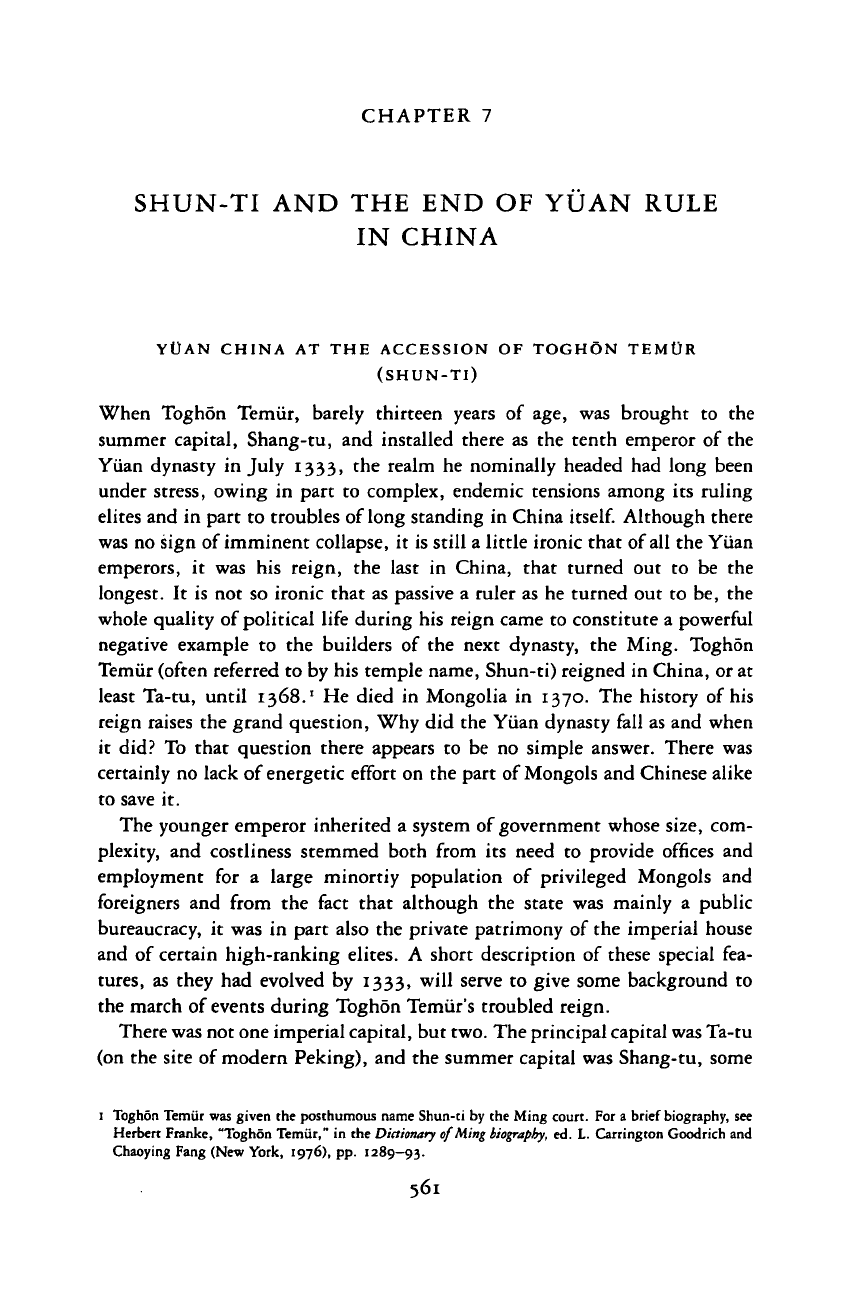
CHAPTER 7
SHUN-TI AND THE END OF YUAN RULE
IN CHINA
YOAN
CHINA
AT THE
ACCESSION
OF
TOGHON
TEMOR
(SHUN-Tl)
When Toghon Temiir, barely thirteen years of age, was brought to the
summer capital, Shang-tu, and installed there as the tenth emperor of the
Yuan dynasty in July 1333, the realm he nominally headed had long been
under stress, owing in part to complex, endemic tensions among its ruling
elites and in part to troubles of long standing in China
itself.
Although there
was no sign of imminent collapse, it is still a little ironic that of
all
the Yuan
emperors, it was his reign, the last in China, that turned out to be the
longest. It is not so ironic that as passive a ruler as he turned out to be, the
whole quality of political life during his reign came to constitute a powerful
negative example to the builders of the next dynasty, the Ming. Toghon
Temiir (often referred to by his temple name, Shun-ti) reigned in China, or at
least Ta-tu, until 1368.' He died in Mongolia in 1370. The history of his
reign raises the grand question, Why did the Yuan dynasty fall as and when
it did? To that question there appears to be no simple answer. There was
certainly no lack of energetic effort on the part of Mongols and Chinese alike
to save it.
The younger emperor inherited a system of government whose size, com-
plexity, and costliness stemmed both from its need to provide offices and
employment for a large minortiy population of privileged Mongols and
foreigners and from the fact that although the state was mainly a public
bureaucracy, it was in part also the private patrimony of the imperial house
and of certain high-ranking elites. A short description of these special fea-
tures,
as they had evolved by 1333, will serve to give some background to
the march of events during Toghon Temiir's troubled reign.
There
was
not one imperial capital, but
two.
The principal capital
was
Ta-tu
(on the site of modern Peking), and the summer capital was Shang-tu, some
1 Toghon Temiir was given the posthumous name Shun-ci by the Ming court. For a brief biography, see
Herbert Franke, "Toghon Temiir," in the Dictionary of Ming
biography,
ed. L. Carrington Goodrich and
Chaoying Fang (New York, 1976), pp. 1289-93.
561
Cambridge Histories Online © Cambridge University Press, 2008

562 SHUN-TI AND THE END OF YOAN RULE IN CHINA
two hundred miles north in the steppes of Inner Mongolia. Toghon Temiir
was enthroned in July 1333 in Shang-tu and returned to Ta-tu in September
or October. Subsequently he faithfully removed his court to Shang-tu every
summer, as a remnant of the nomadic life-style of his forebears. Each year,
until the destruction of Shang-tu by Chinese rebels in January 1359 put an
end to the custom, in the fourth lunar month Toghon Temiir moved north
and in the eighth returned to Ta-tu. The trip north was time-consuming: In
1347 it took twenty-three days.
2
Thus the emperor spent about a month and
a half on the move each year, traveling at the leisurely pace of about ten miles
per day. Each year he took with him a large retinue of officials, who worked
from "branch" offices in Shang-tu during the summer months. These annual
circuits were accomplished at a cost no one has yet tried to calculate, and they
involved a great array of logistical support systems, transport and courier
services, and a host of special traveling agencies. In the 1330s and 1340s,
two southern Chinese literati-officials, Huang Chin and Hu Chu, wrote
enthusiastic, poetic descriptions of these scenic journeys and of the summer
capital. Hu Chu's, the earlier such description, elicited a great deal of
favorable comment.
3
The main capital, too, impressed the literati from south China, and it is to
them we owe several late descriptions and accounts, ranging from the young
Hu Chu's awed reactions to its magnificence and opulence set amid a large
population of very poor people (it was an expensive place to live), to T'ao
Tsung-i's detailed notes on it, and to Hsiao Hsiin's careful inventory, written
in 1368, just before the new Ming government deliberately demolished the
city.
4
The outer walls measured 28.6 kilometers around. The walled imperial
compound toward the city's southern edge, with its central court, palaces,
and lake, took up approximately a twelfth of
the
entire intramural urban area
(see Map 33).
That the Yuan regime still encompassed a patrimonial dimension is evi-
dent in the existence of what amounted to a sort of semipublic, superficially
bureaucratized business empire with holdings in such fields as farming,
palace and temple construction, and manufacturing. Manufacturing took in
everything from the procurement of raw materials to the shipment, storage,
and distribution of an astounding range of
items,
mainly luxury goods. Some
three hundred workshops and other enterprises, mostly in north China, drew
on a labor pool of registered hereditary artisan households to turn out fabrics
of all kinds, foodstuffs, beverages, jewelry, carriages, ironware, felt, tiles,
2 Huang Chin (1277-1357), Huang Wtn-hsim cbi (TSCC ed.), 7, pp. 7ib-72b.
3 Hu Chu (1276—ca. 1353), Ch'un-pai chat lei kao (TSCC ed.), 2, pp. 5a ff.
4 Hou Jen-chih and Chin T'ao,
Pei-ching
shih hua (Shanghai, 1980), pp. 61—95.
Cambridge Histories Online © Cambridge University Press, 2008
